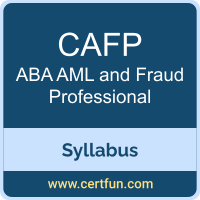 Use this quick start guide to collect all the information about ABA AML and Fraud Professional (CAFP) Certification exam. This study guide provides a list of objectives and resources that will help you prepare for items on the CAFP ABA AML and Fraud Professional exam. The Sample Questions will help you identify the type and difficulty level of the questions and the Practice Exams will make you familiar with the format and environment of an exam. You should refer this guide carefully before attempting your actual ABA AML and Fraud Professional certification exam.
Use this quick start guide to collect all the information about ABA AML and Fraud Professional (CAFP) Certification exam. This study guide provides a list of objectives and resources that will help you prepare for items on the CAFP ABA AML and Fraud Professional exam. The Sample Questions will help you identify the type and difficulty level of the questions and the Practice Exams will make you familiar with the format and environment of an exam. You should refer this guide carefully before attempting your actual ABA AML and Fraud Professional certification exam.
The ABA AML and Fraud Professional certification is mainly targeted to those candidates who want to build their career in Professional Level domain. The ABA Certified AML and Fraud Professional (CAFP) exam verifies that the candidate possesses the fundamental knowledge and proven skills in the area of ABA AML and Fraud Professional.
ABA AML and Fraud Professional Exam Summary:
| Exam Name | ABA Certified AML and Fraud Professional (CAFP) |
| Exam Code | CAFP |
| Exam Price | $575 (USD) |
| Duration | 180 mins |
| Number of Questions | 150 |
| Passing Score | Pass/Fail |
| Books / Training | CAFP Exam Online Prep |
| Schedule Exam | EXAM APPLICATION |
| Sample Questions | ABA AML and Fraud Professional Sample Questions |
| Practice Exam | ABA CAFP Certification Practice Exam |
ABA CAFP Exam Syllabus Topics:
| Topic | Details |
|---|---|
Program Governance - 34% |
|
| Establish procedures and controls to effectively address Bank Secrecy Act (BSA) / Anti-Money Laundering (AML) compliance guidance and regulatory requirements. |
Knowledge required:
|
| Establish procedures and controls to effectively address Office of Foreign Assets Control (OFAC) compliance guidance and regulatory requirements. |
Knowledge required:
|
| Establish procedures and controls to effectively address Fraud compliance guidance and regulatory requirements. |
Knowledge required:
|
| Understand AML, OFAC, and Fraud risk assessment processes. |
Knowledge required:
|
| Implement the Anti-Money Laundering Act (AMLA). |
Knowledge required:
|
Detection and Investigation - 30% |
|
| Develop strategies and models for system alert generation. |
Knowledge required:
|
| Identify and understand red flags and alert analysis. |
Knowledge required:
|
| Investigate the case by reviewing and determining the activity type, identifying suspects (i.e., known, unknown) and victims. |
Knowledge required:
|
| Conclude investigation with supporting documentation and SAR decisioning. |
Knowledge required:
|
| Determine the next course of action (e.g., account closure, reporting) in a case based on the identified risk. |
Knowledge required:
|
Reporting - 26% |
|
| Understand regulatory reporting and filing requirements (e.g., currency transaction reports [CTRs], suspicious activity reports [SARs], FACTA Red Flags Rule, Foreign Bank and Financial Accounts [FBAR], Designation of Exempt Person [DOEP]). |
Knowledge required:
|
| Respond to information requests. |
Knowledge required:
|
To ensure success in ABA AML and Fraud Professional certification exam, we recommend authorized training course, practice test and hands-on experience to prepare for ABA AML and Fraud Professional (CAFP) exam.
